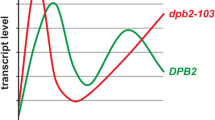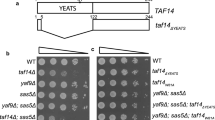Abstract
Ndt80 contributes to the highly regulated cascade of sequential gene expression that directs spore formation in Saccharomyces cerevisiae. This DNA-binding transcriptional activator, which is responsible for the expression of a set of middle sporulation-specific genes, is a target of the meiotic recombination checkpoint. Triggering of this checkpoint prevents phosphorylation and accumulation of active Ndt80. In this study we have investigated the requirements for the activation function of Ndt80 by exploring the role of phosphorylation in the regulation of its activity and by examining the effect of C-terminal truncations. Of three phosphoforms of Ndt80 that we resolved, which we refer to as P~Ndt80′′, P~Ndt80′, and P~Ndt80 in order of increasing electrophoretic mobility, the P~Ndt80′′ and P~Ndt80′ isoforms correlated with active Ndt80. In particular, P~Ndt80′′ was present in lysates from wild-type sporulating cells and in cells that bypassed checkpoint-mediated arrest as a result of mutations in RAD17, SUM1 , or SWE1, or overexpression of NDT80. P~Ndt80′ was the slowest-migrating isoform that accumulated in Δ ime2/Δ ime2 Δ sum1/Δ sum1 cells in sporulation medium and in mitotic cells that ectopically expressed NDT80. Nonphosphorylated Ndt80 and P~Ndt80, which had a slightly lower mobility than nonphosphorylated Ndt80 and was the predominant phosphoform present in checkpoint-arrested cells, correlated with inactive Ndt80. These data are consistent with the notion that extensive phosphorylation, but not Ime2-dependent phosphorylation, of Ndt80 is required for its activity. Examination of the effect of increasingly extensive truncation of the C terminal region of Ndt80 revealed that some functions of Ndt80 were more sensitive to a reduction in its activity than others. In particular, we found that a truncated version of Ndt80 that lacked the last 110 residues was able to promote expression of some middle sporulation-specific genes, but could not direct spore formation. Full activity, however, could be restored to this version of Ndt80 by increasing its level of expression.




Similar content being viewed by others
References
Benjamin KR, Zhang C, Shokat KM, Herskowitz I (2003) Control of landmark events in meiosis by the CDK Cdc28 and the meiosis-specific kinase Ime2. Genes Dev 17:1524–1539
Bishop DK, Park D, Xu L, Kleckner N (1992) DMC1: a meiosis-specific yeast homolog of E. coli recA required for recombination, synaptonemal complex formation, and cell cycle progression. Cell 69:439–456
Bolte M, Steigemann P, Braus GH, Irniger S (2002) Inhibition of APC-mediated proteolysis by the meiosis-specific protein kinase Ime2. Proc Natl Acad Sci USA 99:4385–4390
Booher RN, Deshaies RJ, Kirschner MW (1993) Properties of Saccharomyces cerevisiae wee1 and its differential regulation of p34CDC28 in response to G1 and G2 cyclins. EMBO J 12:3417–3426
Brush GS, Morrow DM, Hieter P, Kelly TJ (1996) The ATM homologue MEC1 is required for phosphorylation of replication protein A in yeast. Proc Natl Acad Sci USA 93:15075–15080
Chu S, Herskowitz I (1998) Gametogenesis in yeast is regulated by a transcriptional cascade dependent on Ndt80. Mol Cell 1:685–696
Chu S, DeRisi J, Eisen M, Mulholland J, Botstein D, Brown PO, Herskowitz I (1998) The transcriptional program of sporulation in budding yeast. Science 282:699–705
Clancy MJ (1998) Meiosis: step-by-step through sporulation. Curr Biol 8:R461–463
Dahmann C, Futcher B (1995) Specialization of B-type cyclins for mitosis or meiosis in S. cerevisiae. Genetics 140:957–963
Dirick L, Goetsch L, Ammerer G, Byers B (1998) Regulation of meiotic S phase by Ime2 and a Clb5,6-associated kinase in Saccharomyces cerevisiae. Science 281:1854–1857
Foiani M, Nadjar-Boger E, Capone R, Sagee S, Hashimshoni T, Kassir Y (1996) A meiosis-specific protein kinase, Ime2, is required for the correct timing of DNA replication and for spore formation in yeast meiosis. Mol Gen Genet 253:278–288
Garber AT, Segall J (1986) The SPS4 gene of Saccharomyces cerevisiae encodes a major sporulation-specific mRNA. Mol Cell Biol 6:4478–4485
Gietz D, St Jean A, Woods RA, Schiestl RH (1992) Improved method for high efficiency transformation of intact yeast cells. Nucleic Acids Res 20:1425
Grandin N, Reed SI (1993) Differential function and expression of Saccharomyces cerevisiae B-type cyclins in mitosis and meiosis. Mol Cell Biol 13:2113–2125
Guttmann-Raviv N, Boger-Nadjar E, Edri I, Kassir Y (2001) Cdc28 and Ime2 possess redundant functions in promoting entry into premeiotic DNA replication in Saccharomyces cerevisiae. Genetics 159:1547–1558
Guttmann-Raviv N, Martin S, Kassir Y (2002) Ime2, a meiosis-specific kinase in yeast, is required for destabilization of its transcriptional activator, Ime1. Mol Cell Biol 22:2047–2056
Hepworth SR, Ebisuzaki LK, Segall J (1995) A 15-base-pair element activates the SPS4 gene midway through sporulation in Saccharomyces cerevisiae. Mol Cell Biol 15:3934–3944
Hepworth SR, Friesen H, Segall J (1998) NDT80 and the meiotic recombination checkpoint regulate expression of middle sporulation-specific genes in Saccharomyces cerevisiae. Mol Cell Biol 18:5750–5761
Ho SN, Hunt HD, Horton RM, Pullen JK, Pease LR (1989) Site-directed mutagenesis by overlap extension using the polymerase chain reaction. Gene 77:51–59
Honigberg SM, Purnapatre K (2003) Signal pathway integration in the switch from the mitotic cell cycle to meiosis in yeast. J Cell Sci 116:2137–2147
Kupiec M, Byers B, Esposito RE, Mitchell AP (1997) Meiosis and sporulation in Saccharomyces cerevisiae. In: Pringle JR, Broach JR, Jones EW (eds) The molecular biology of the yeast Saccharomyces: cell cycle and cell biology, vol 3. Cold Spring Harbor Laboratory Press, Cold Spring Harbor, N.Y. pp 899–1036
Lamoureux JS, Stuart D, Tsang R, Wu C, Glover JN (2002) Structure of the sporulation-specific transcription factor Ndt80 bound to DNA. EMBO J 21:5721–5732
Law DT, Segall J (1988) The SPS100 gene of Saccharomyces cerevisiae is activated late in the sporulation process and contributes to spore wall maturation. Mol Cell Biol 8:912–922
Leu JY, Roeder GS (1999) The pachytene checkpoint in S. cerevisiae depends on Swe1-mediated phosphorylation of the cyclin-dependent kinase Cdc28. Mol Cell 4:805–814
Lindgren A, Bungard D, Pierce M, Xie J, Vershon A, Winter E (2000) The pachytene checkpoint in Saccharomyces cerevisiae requires the Sum1 transcriptional repressor. EMBO J 19:6489–6497
Longtine MS, McKenzie A 3rd, Demarini DJ, Shah NG, Wach A, Brachat A, Philippsen P, Pringle JR (1998) Additional modules for versatile and economical PCR-based gene deletion and modification in Saccharomyces cerevisiae. Yeast 14:953–961
Lydall D, Nikolsky Y, Bishop DK, Weinert T (1996) A meiotic recombination checkpoint controlled by mitotic checkpoint genes. Nature 383:840–843
Mitchell AP (1994) Control of meiotic gene expression in Saccharomyces cerevisiae. Microbiol Rev 58:56–70
Mitchell AP, Driscoll SE, Smith HE (1990) Positive control of sporulation-specific genes by the IME1 and IME2 products in Saccharomyces cerevisiae. Mol Cell Biol 10:2104–2110
Montano SP, Pierce M, Cote ML, Vershon AK, Georgiadis MM (2002) Crystallographic studies of a novel DNA-binding domain from the yeast transcriptional activator Ndt80. Acta Crystallogr D Biol Crystallogr 58:2127–2130
Murakami H, Nurse P (2000) DNA replication and damage checkpoints and meiotic cell cycle controls in the fission and budding yeasts. Biochem J 349:1–12
Page AW, Orr-Weaver TL (1997) Stopping and starting the meiotic cell cycle. Curr Opin Genet Dev 7:23–31
Pak J, Segall J (2002a) Regulation of the premiddle and middle phases of expression of the NDT80 gene during sporulation of Saccharomyces cerevisiae. Mol Cell Biol 22:6417–6429
Pak J, Segall J (2002b) Role of Ndt80, Sum1, and Swe1 as targets of the meiotic recombination checkpoint that control exit from pachytene and spore formation in Saccharomyces cerevisiae. Mol Cell Biol 22:6430–6440
Percival-Smith A, Segall J (1986) Characterization and mutational analysis of a cluster of three genes expressed preferentially during sporulation of Saccharomyces cerevisiae. Mol Cell Biol 6:2443–2451
Primig M, Williams RM, Winzeler EA, Tevzadze GG, Conway AR, Hwang SY, Davis RW, Esposito RE (2000) The core meiotic transcriptome in budding yeasts. Nat Genet 26:415–423
Rabitsch KP, Toth A, Galova M, Schleiffer A, Schaffner G, Aigner E, Rupp C, Penkner AM, Moreno-Borchart AC, Primig M, Esposito RE, Klein F, Knop M, Nasmyth K (2001) A screen for genes required for meiosis and spore formation based on whole-genome expression. Curr Biol 11:1001–1009
Roeder GS, Bailis JM (2000) The pachytene checkpoint. Trends Genet 16:395–403
Rowland O, Segall J (1998) A hydrophobic segment within the 81-amino-acid domain of TFIIIA from Saccharomyces cerevisiae is essential for its transcription factor activity. Mol Cell Biol 18:420–432
Shuster EO, Byers B (1989) Pachytene arrest and other meiotic effects of the start mutations in Saccharomyces cerevisiae. Genetics 123:29–43
Sopko R, Raithatha S, Stuart D (2002) Phosphorylation and maximal activity of Saccharomyces cerevisiae meiosis-specific transcription factor Ndt80 is dependent on Ime2. Mol Cell Biol 22:7024–7040
Tung KS, Hong EJ, Roeder GS (2000) The pachytene checkpoint prevents accumulation and phosphorylation of the meiosis-specific transcription factor Ndt80. Proc Natl Acad Sci USA 97:12187–12192
Vershon AK, Pierce M (2000) Transcriptional regulation of meiosis in yeast. Curr Opin Cell Biol 12:334–339
Xie J, Pierce M, Gailus-Durner V, Wagner M, Winter E, Vershon AK (1999) Sum1 and Hst1 repress middle sporulation-specific gene expression during mitosis in Saccharomyces cerevisiae. EMBO J 18:6448–6454
Xu L, Ajimura M, Padmore R, Klein C, Kleckner N (1995) NDT80, a meiosis-specific gene required for exit from pachytene in Saccharomyces cerevisiae. Mol Cell Biol 15:6572–6581
Xu L, Weiner BM, Kleckner N (1997) Meiotic cells monitor the status of the interhomolog recombination complex. Genes Dev 11:106–118
Yoshida M, Kawaguchi H, Sakata Y, Kominami K, Hirano M, Shima H, Akada R, Yamashita I (1990) Initiation of meiosis and sporulation in Saccharomyces cerevisiae requires a novel protein kinase homologue. Mol Gen Genet 221:176–186
Zickler D, Kleckner N (1999) Meiotic chromosomes: integrating structure and function. Annu Rev Genet 33:603–754
Acknowledgements
We thank George Brush for his advice on electrophoretic separation of phosphoproteins, and we thank members of our laboratory and Dr. Helena Friesen for helpful comments on this manuscript. This work was supported by a Canadian Institute of Health Research Grant (MOP-6826) to J.S. N.L. was supported in part by a Life Sciences Summer Studentship from the University of Toronto
Author information
Authors and Affiliations
Corresponding author
Additional information
Communicated by D. Y. Thomas
Rights and permissions
About this article
Cite this article
Shubassi, G., Luca, N., Pak, J. et al. Activity of phosphoforms and truncated versions of Ndt80, a checkpoint-regulated sporulation-specific transcription factor of Saccharomyces cerevisiae . Mol Genet Genomics 270, 324–336 (2003). https://doi.org/10.1007/s00438-003-0922-3
Received:
Accepted:
Published:
Issue Date:
DOI: https://doi.org/10.1007/s00438-003-0922-3




